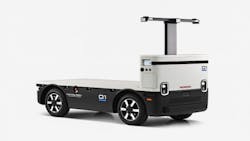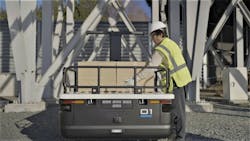Vision Systems Design: What other types of industries and work activities does Honda envision for this vehicle in the future?
VanBuren: While AWV’s initial target industry is construction, we are looking for opportunities to expand AWV’s capabilities to industries like transportation, agriculture, mining, and other industries facing labor shortages.
Vision Systems Design: When does Honda believe it will begin commercial production of the autonomous work vehicle?
VanBuren: Honda has not announced commercialization details. We will continue to advance the AWV platform with field testing partners as we work toward future commercialization.
Vision Systems Design: What sensors are used in obstacle avoidance and navigation and how do they work?
VanBuren: The Honda AWV employs a suite of sensors to operate autonomously, including GPS, LiDAR, and Honda’s own proprietary odometry—using data from motion sensors to precisely navigate a construction site.
The third-generation AWV also features improved navigation capabilities in locations where GNSS (global navigation satellite system) service is weak or unavailable through the use of LiDAR sensors.
Vision Systems Design: Will you describe the role of the stereoscopic 3D cameras in providing remote monitoring?
VanBuren: The stereoscopic 3D cameras are used for remote monitoring and can support remote operation when used by remote control. For instance, the Honda AWV could be used to perform perimeter security services at job sites during non-work hours.
Vision Systems Design: How do they work?
VanBuren: For proprietary reasons, we are not currently sharing this information.
Vision Systems Design: What did Honda learn from the field tests the company conducted with the AWV at a large-scale solar construction site?
VanBuren: Our month-long field test with Black & Veatch (Overland Park, KS, USA; www.bv.com/news), along with other field tests with multiple partners, validated the performance and suitability of multiple Honda AWV units that worked collaboratively across various styles of construction sites.
Honda produced a high-definition map of all worksites that allowed operators to precisely set start and stop points for multiple Honda AWVs using a cloud-based app interface that runs on tablets and PCs. The vehicles successfully delivered materials and supplies along a calculated route and proved capable of stopping within centimeters of the pre-set points.
The field test also demonstrated the viability of the Honda AWV battery system to support energy-intensive sensors and provide vehicle propulsion, while operating up to eight hours in a high-temperature environment. The vehicle carried payloads of nearly 900 lbs, and in a separate use case towed a trailer carrying over 1,600 lbs.
These learnings were integral to developing the third-generation Honda AWV. The third-generation AWV features a number of enhancements, including:
- Increased bed size to two pallets and greater loading capacity of 2,000 pounds to meet the demands of transporting construction materials
- Higher speed in autonomous mode up to 10 mph to meet maximum speed on worksite roads
- Increased battery size to 18.6kWh and longer operating time of up to 10 hours
About the Author
Linda Wilson
Editor in Chief
Linda Wilson joined the team at Vision Systems Design in 2022. She has more than 25 years of experience in B2B publishing and has written for numerous publications, including Modern Healthcare, InformationWeek, Computerworld, Health Data Management, and many others. Before joining VSD, she was the senior editor at Medical Laboratory Observer, a sister publication to VSD.


